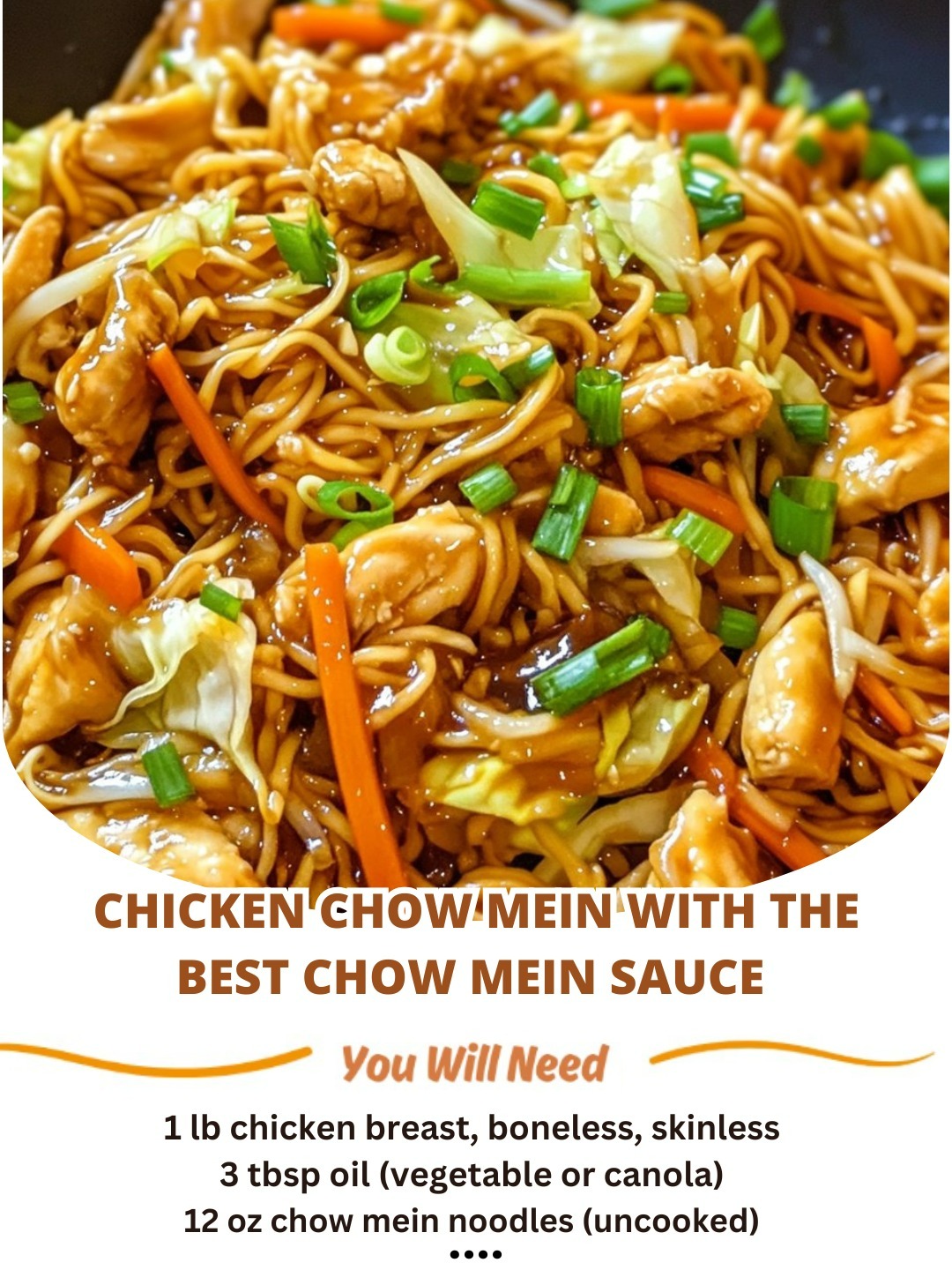ADVERTISEMENT
### **Step-by-Step Instructions for Chicken Chow Mein**
#### **1. Cook the Noodles:**
– Bring a pot of water to a boil. Cook the chow mein noodles according to the package instructions. Once cooked, drain and set aside. If you’re using lo mein noodles, you can cook them the same way.
#### **2. Make the Chow Mein Sauce:**
– In a small bowl, whisk together the soy sauce, oyster sauce, hoisin sauce, sesame oil, rice vinegar, sugar, chicken broth, cornstarch, and cracked black pepper. Make sure the cornstarch is fully dissolved to prevent clumping. Set the sauce aside.
#### **3. Cook the Chicken:**
– Heat 1 tablespoon of vegetable oil in a large skillet or wok over medium-high heat. Add the sliced chicken breast or thighs to the pan, season with a pinch of salt and pepper, and stir-fry for 4-5 minutes, or until the chicken is cooked through and lightly browned on the edges. Remove the chicken from the pan and set it aside.
#### **4. Stir-Fry the Veggies:**
– In the same skillet or wok, add a little more oil if needed. Add the onion, bell peppers, and carrots. Stir-fry for 3-4 minutes, or until the vegetables are slightly tender but still crisp. Add the cabbage, garlic, and ginger (if using), and cook for an additional 2 minutes, until fragrant.
#### **5. Combine the Chicken and Noodles:**
– Return the cooked chicken to the pan with the vegetables. Add the cooked noodles to the pan as well. Pour the prepared chow mein sauce over the top and toss everything together to ensure the noodles, chicken, and veggies are well-coated in the sauce.
#### **6. Cook the Chow Mein:**
– Let the chow mein cook for another 2-3 minutes, stirring occasionally, so the noodles can absorb the sauce and everything heats through. If the noodles start to stick, add a splash of chicken or vegetable broth to loosen them up.
#### **7. Serve and Enjoy:**
– Once everything is well combined and heated through, taste and adjust the seasoning, adding more soy sauce or pepper as needed. Serve the chicken chow mein hot, garnished with sesame seeds, green onions, or cilantro for extra freshness and crunch.
### **Why This Chow Mein Sauce is the Best**
The sauce in this recipe is truly what takes the dish from good to great. Here’s why it’s the best:
– **Perfect Balance of Flavors:** The combination of soy sauce, oyster sauce, and hoisin sauce creates a deep umami flavor, while the rice vinegar adds a slight tang, and the sugar gives it just the right amount of sweetness.
– **Silky Texture:** The cornstarch in the sauce thickens it to create a smooth, velvety coating that clings to the noodles and chicken without being too heavy.
– **Customizable:** Adjust the sugar or vinegar to your liking depending on how sweet or tangy you like your chow mein. You can also add chili sauce for a little heat if desired.
### **Why This Recipe is So Great**
– **One-Pan Wonder:** This recipe is incredibly convenient since everything is made in one skillet or wok. Not only does this cut down on cleanup, but it also allows the flavors to meld together beautifully.
– **Versatile:** Chicken is the star of this recipe, but feel free to swap it out for other proteins like shrimp, beef, or even tofu for a vegetarian version. You can also mix up the vegetables to suit what you have on hand—broccoli, snap peas, or mushrooms all make great additions!
– **Quick & Easy:** This chicken chow mein recipe comes together in under 30 minutes, making it an ideal choice for busy nights when you don’t want to order takeout but still want a delicious, homemade meal.
### **Customization Ideas**
– **Add More Veggies:** Feel free to get creative with your vegetables. Try adding snow peas, baby corn, bok choy, or mushrooms for additional flavors and textures.
– **Spicy Version:** If you love heat, add a tablespoon of chili paste or a sprinkle of crushed red pepper flakes to the sauce, or toss in some sliced fresh chilies while stir-frying.
– **Protein Variations:** This dish works with so many proteins! Swap out the chicken for shrimp, pork, or beef—just adjust the cooking times as needed. You can also make it vegetarian by using tofu or tempeh.
– **Make it Gluten-Free:** For a gluten-free version, use tamari instead of soy sauce, and choose gluten-free chow mein or rice noodles.
### **Healthier Twist**
You can lighten up this recipe with a few simple tweaks:
– **Lower-Sodium Option:** Use low-sodium soy sauce and reduce the amount of sugar for a healthier version that still has tons of flavor.
– **More Veggies:** Add even more vegetables like zucchini, bell peppers, and broccoli to increase the nutritional value of the dish.
– **Lean Protein:** Swap the chicken for leaner cuts, like skinless chicken breast, or choose a plant-based protein like tofu or tempeh for a healthier alternative.
### **Conclusion**
**Chicken Chow Mein with the Best Chow Mein Sauce** is the ultimate stir-fry dish that brings together tender chicken, fresh vegetables, and flavorful noodles in a savory sauce that’s simply irresistible. It’s quick, easy, and perfect for busy weeknights, but it’s also impressive enough to serve to guests. With its customizable ingredients and endless variations, this recipe will quickly become a family favorite.
Give it a try and discover how a homemade version of chow mein can beat takeout any day of the week. The combination of savory sauce, tender chicken, and crisp vegetables is the perfect way to satisfy your stir-fry cravings—no delivery required!
ADVERTISEMENT
ADVERTISEMENT


